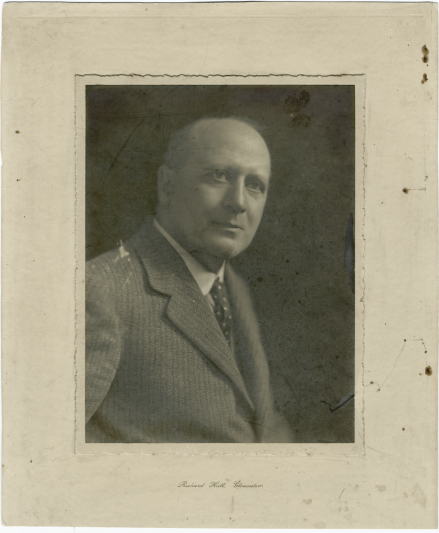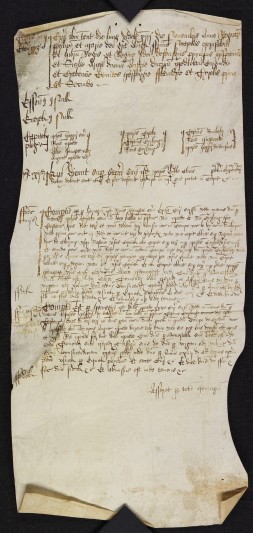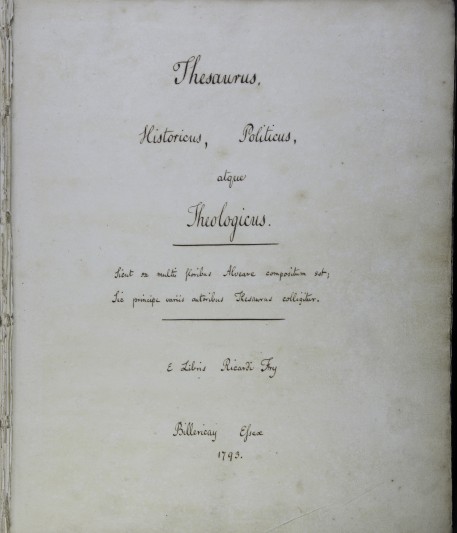The manuscript’s value lies not only in the wealth of detail it provides about this otherwise little known episode in British diplomatic history but also in Lewis’s copious observations on the island of Madagascar itself. A sketch map of the island is one of the earliest to contain demographic information and Lewis also included geodetic data, enabling him to calculate the size of this huge land mass. A fold-out map of the harbour of Tamatave is possibly the earliest cartographic representation of this port. Lewis appears to have been particularly interested in the languages of Madagascar and the manuscript includes an Ovah alphabet.
Search FNL grants since 1931
Prior to its acquisition by the Keats-Shelley Memorial Association, John Keats’s letter to Thomas Monkhouse, dated 21 June 1818, had always been in private hands and hardly ever seen by scholars.
To the best of our knowledge the drawings are not in any public record office and they complement material presented by the Rennie family some years ago. We have both John and Sir John Rennie’s report books including one volume specifically relating to the Lancaster Canal. We also have a volume of specifications relating to the canal. Although we have a number of prints of engineering works which belonged to the family there are only a few drawings and no original drawings of his canal schemes. It is ICE policy to collect drawings representative of the full range of works carried out by the profession historically.
The drawings show proposed structures to be built on the canal and are dated 1794. They are all signed by Rennie and the contractor.
A significant quantity of papers of John ('Jack') Wilton Haines (1875-1960), dubbed the ‘friend of poets’ by Walter de la Mare. Important in their own right, these papers are also intimately related to the J W Haines archive which we already hold and with which they can now be re-united.
It was fortuitous for Haines that many leading cultural figures of the early 20th century were Gloucestershire residents. A surplus of empty, cheap cottages for rent in the village of Dymock, near Gloucester, had attracted a gathering of lowly paid, often impoverished poets and their families including Robert Frost, Wilfrid Gibson, Lascelles Abercrombie and Rupert Brooke.
Fifty seven issues of the rare Dutch art, design and architecture periodical Wendingen. Published monthly between 1918 and 1932, initially by the Amsterdam-based de Hooge Brug, and from 1924, the Santpoort firm of C.A.Mees, Wendingen is regarded as one of the most progressive publications of its time. Each issue was considered an art object in itself, and was printed on double-fold paper, hand-bound with raffia, and wrapped with a lithographed or woodcut cover specifically designed for its theme by a member of the artistic avant-garde. The magazine’s highly experimental typography extended to its advertisements, which were integrated into the overall design.
Lambton was widely acknowledged in his lifetime as one of the foremost political figures of his generation. He was very well connected, regionally, nationally and internationally, through familial, personal and professional relationships; and his role in the campaign for reform placed him at the centre of English politics. He was also a complex character full of contradictions. His personal life was punctuated in the early 1830s by a series of bereavements, which left him devastated. The effects were noticeable within his public life, where he had a reputation for being short-tempered and obstinate as well as energetic and radical. He lived the life of a wealthy aristocrat, able as he put it, to ‘jog along’ on £40,000 a year, and pursued interests in literature, art and science. The archive reflects the breadth of his career and personal connections, and promises to reveal a compelling narrative of events and provide insights into the views and actions of those involved.
Clavering is a small parish in high North-West Essex, once the tiny capital of the Half-Hundred of Clavering but now known mainly for picturesque views and for a certain celebrity chef.
The leading manor was the Manor of Clavering, associated with the remains of an early castle. Curles was one of two smaller manors, its moated manor house lying about half a mile from the village centre. The ownership of these manors is slightly obscure, but they seem to have been held generally by the Barlee family of minor local gentry. The last of their line died at Curles in 1757. At the period of these rolls, however, the family seem to have been in some distress: they sold the reversion of one manor in 1568, and in 1563 a lease of Curles itself had been granted to a local yeoman by one Margaret Fulvelbye, a Cambridgeshire widow. The lease specifically excluded the profits of this manor court.
The records present themselves as eight rolls, each relating to a single sitting of the court.
These papers are derived from the activities of the Hastings mercantile and political family of Milward, whose prominence in the town was further enhanced by the marriage in 1754 of Edward Milward (1723-1811) to Mary Collier, one of the five daughters of John Collier.
Whenever war with France threatened, the men of the maritime towns of Sussex hurried to obtain Letters of Marque and Reprisal – licences granted by the Crown giving authority to fit out an armed vessel and use it in the capture of enemy merchant shipping, and to commit acts which would otherwise have constituted piracy. These papers relate to the exploits of three such vessels, all equipped by Hastings merchants during the Seven Years’ War (1756-1763) – the privateers Lyon and Fox, and the cutter Triton.
In about 1970 a young articled clerk at a solicitor’s firm in the Sussex market town of Battle was required by his principal to clear old papers from a room above the stables in the office yard. Most were destroyed, but the young man could not bear to consign a few of them to oblivion; he knew that the ones he could read were of importance and guessed, quite rightly as it transpired, that those he could not were probably very old.
Fifty years later that articled clerk, now a pillar of the legal community in the West of England, decided that it was time to realise the value of what he had salvaged. His haul formed Lots 376-380 at the Clevedon Salerooms in March 2018.
The Library was very pleased to acquire a substantial manuscript commonplace book by Richard Fry (1759-1842) largely dating from the early 19th century. Fry is an interesting figure in the history of 19th-century Congregationalism and Unitarianism and the subject of a major controversy in 1798. Born at Devonport into a Congregational family, he trained for the ministry first at the Western Academy, Bridport, and then from 1778 at Homerton Academy in London. He entered the ministry at Warminster, Wiltshire, in 1781, and in 1785 he moved to Billericay in Essex. His ministry was at first uncontroversial, and he enjoyed some success, but his religious opinions gradually altered and a number in his congregation detected a departure from orthodox Calvinism.








